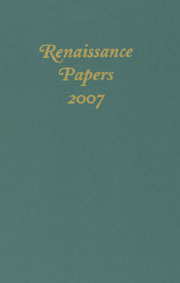Book contents
- Frontmatter
- Contents
- Renaissance Papers
- John Donne and the Practice of Priesthood
- Charity, Halifax, and Utopia: The Disadvantageous Setting of Thomas Browne's Religio Medici
- Presbyterian Church and State Before The Solemn League and Covenant
- The Flaw in Paradise: The Critique of Idealism in Margaret Cavendish's The Blazing World
- “Conceited portraiture before his Book … to catch fools and silly gazers”: Some Reflections on Paradise Lost and the Tradition of the Engraved Frontispiece
- “But Smythes Must Speake”: Women's and Commoners' Voices in the Mirror for Magistrates
- Fit for a King: The Manuscript Psalms of King James VI/I
- The Suicide of Lavinia: Finding Rome in Titus Andronicus
- The Language of Gods: Rhetoric and the Construction of Masculinity in Julius Caesar
Fit for a King: The Manuscript Psalms of King James VI/I
Published online by Cambridge University Press: 12 September 2012
- Frontmatter
- Contents
- Renaissance Papers
- John Donne and the Practice of Priesthood
- Charity, Halifax, and Utopia: The Disadvantageous Setting of Thomas Browne's Religio Medici
- Presbyterian Church and State Before The Solemn League and Covenant
- The Flaw in Paradise: The Critique of Idealism in Margaret Cavendish's The Blazing World
- “Conceited portraiture before his Book … to catch fools and silly gazers”: Some Reflections on Paradise Lost and the Tradition of the Engraved Frontispiece
- “But Smythes Must Speake”: Women's and Commoners' Voices in the Mirror for Magistrates
- Fit for a King: The Manuscript Psalms of King James VI/I
- The Suicide of Lavinia: Finding Rome in Titus Andronicus
- The Language of Gods: Rhetoric and the Construction of Masculinity in Julius Caesar
Summary
IT is rarely noted that King James–the sixth of Scotland, the first of England—translated thirty of King David's Psalms into original Scots verse. But there they are, in his own hand, in the undated British Library manuscript Royal 18.B.xvi. James Craigie first published them in 1958 in volume 2 of The Poems of James VI of Scotland. William McMillan and James Doelman have both written insightfully about the afterlife of James's Psalms: how they were completely re-rendered by William Alexander, how competing efforts such as George Wither's were discouraged, and how Charles I passed off Alexander's Psalms as the Psalms of his father. This pseudo-James Psalter was published in Oxford in 1631 and was placed at the back of Laud's prayer book, which was to cause a riot in Edinburgh in 1637. Any text that inspires someone to throw furniture at someone else—as Jenny Geddes did with her stool in Edinburgh—rightfully captures our attention. But a reading of the Psalms James actually wrote in his manuscript is necessary because, as far as I know, no critic has published a reading of them. A reading of James's manuscript Psalms will also give us insight to his character, his desire to pattern himself after King David, and more broadly, help us understand how monarchy was constructed in the Stuart era. I will use the sixth Psalm, Domine ne in furore, as a test case.
- Type
- Chapter
- Information
- Renaissance Papers 2007 , pp. 97 - 110Publisher: Boydell & BrewerPrint publication year: 2008



